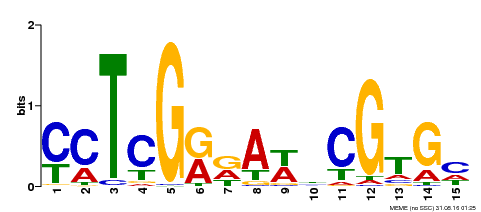- Krizek BA,Prost V,Macias A
AINTEGUMENTA promotes petal identity and acts as a negative regulator of AGAMOUS.
Plant Cell, 2000. 12(8): p. 1357-66
[PMID:10948255] - Riechmann JL, et al.
Arabidopsis transcription factors: genome-wide comparative analysis among eukaryotes.
Science, 2000. 290(5499): p. 2105-10
[PMID:11118137] - Nole-Wilson S,Tranby TL,Krizek BA
AINTEGUMENTA-like (AIL) genes are expressed in young tissues and may specify meristematic or division-competent states.
Plant Mol. Biol., 2005. 57(5): p. 613-28
[PMID:15988559] - Kim S,Soltis PS,Wall K,Soltis DE
Phylogeny and domain evolution in the APETALA2-like gene family.
Mol. Biol. Evol., 2006. 23(1): p. 107-20
[PMID:16151182] - Galinha C, et al.
PLETHORA proteins as dose-dependent master regulators of Arabidopsis root development.
Nature, 2007. 449(7165): p. 1053-7
[PMID:17960244] - Krizek B
AINTEGUMENTA and AINTEGUMENTA-LIKE6 act redundantly to regulate Arabidopsis floral growth and patterning.
Plant Physiol., 2009. 150(4): p. 1916-29
[PMID:19542297] - Krizek BA
Aintegumenta and Aintegumenta-Like6 regulate auxin-mediated flower development in Arabidopsis.
BMC Res Notes, 2011. 4: p. 176
[PMID:21645408] - Prasad K, et al.
Arabidopsis PLETHORA transcription factors control phyllotaxis.
Curr. Biol., 2011. 21(13): p. 1123-8
[PMID:21700457] - Gaudinier A, et al.
Enhanced Y1H assays for Arabidopsis.
Nat. Methods, 2011. 8(12): p. 1053-5
[PMID:22037706] - Krizek BA,Eaddy M
AINTEGUMENTA-LIKE6 regulates cellular differentiation in flowers.
Plant Mol. Biol., 2012. 78(3): p. 199-209
[PMID:22076630] - Mudunkothge JS,Krizek BA
Three Arabidopsis AIL/PLT genes act in combination to regulate shoot apical meristem function.
Plant J., 2012. 71(1): p. 108-21
[PMID:22380923] - Dhonukshe P, et al.
A PLETHORA-auxin transcription module controls cell division plane rotation through MAP65 and CLASP.
Cell, 2012. 149(2): p. 383-96
[PMID:22500804] - Pinon V,Prasad K,Grigg SP,Sanchez-Perez GF,Scheres B
Local auxin biosynthesis regulation by PLETHORA transcription factors controls phyllotaxis in Arabidopsis.
Proc. Natl. Acad. Sci. U.S.A., 2013. 110(3): p. 1107-12
[PMID:23277580] - Yamaguchi N, et al.
A molecular framework for auxin-mediated initiation of flower primordia.
Dev. Cell, 2013. 24(3): p. 271-82
[PMID:23375585] - Hofhuis H, et al.
Phyllotaxis and rhizotaxis in Arabidopsis are modified by three PLETHORA transcription factors.
Curr. Biol., 2013. 23(11): p. 956-62
[PMID:23684976] - Jin J, et al.
An Arabidopsis Transcriptional Regulatory Map Reveals Distinct Functional and Evolutionary Features of Novel Transcription Factors.
Mol. Biol. Evol., 2015. 32(7): p. 1767-73
[PMID:25750178] - Kareem A, et al.
PLETHORA Genes Control Regeneration by a Two-Step Mechanism.
Curr. Biol., 2015. 25(8): p. 1017-30
[PMID:25819565] - Krizek BA
AINTEGUMENTA-LIKE genes have partly overlapping functions with AINTEGUMENTA but make distinct contributions to Arabidopsis thaliana flower development.
J. Exp. Bot., 2015. 66(15): p. 4537-49
[PMID:25956884] - Krizek BA
Intronic sequences are required for AINTEGUMENTA-LIKE6 expression in Arabidopsis flowers.
BMC Res Notes, 2015. 8: p. 556
[PMID:26459062] - Yamaguchi N,Jeong CW,Nole-Wilson S,Krizek BA,Wagner D
AINTEGUMENTA and AINTEGUMENTA-LIKE6/PLETHORA3 Induce LEAFY Expression in Response to Auxin to Promote the Onset of Flower Formation in Arabidopsis.
Plant Physiol., 2016. 170(1): p. 283-93
[PMID:26537561] - Krizek BA, et al.
RNA-Seq Links the Transcription Factors AINTEGUMENTA and AINTEGUMENTA-LIKE6 to Cell Wall Remodeling and Plant Defense Pathways.
Plant Physiol., 2016. 171(3): p. 2069-84
[PMID:27208279] - Du Y,Scheres B
PLETHORA transcription factors orchestrate de novo organ patterning during Arabidopsis lateral root outgrowth.
Proc. Natl. Acad. Sci. U.S.A., 2017. 114(44): p. 11709-11714
[PMID:29078398] - Klucher KM,Chow H,Reiser L,Fischer RL
The AINTEGUMENTA gene of Arabidopsis required for ovule and female gametophyte development is related to the floral homeotic gene APETALA2.
Plant Cell, 1996. 8(2): p. 137-53
[PMID:8742706] - Elliott RC, et al.
AINTEGUMENTA, an APETALA2-like gene of Arabidopsis with pleiotropic roles in ovule development and floral organ growth.
Plant Cell, 1996. 8(2): p. 155-68
[PMID:8742707] - Okamuro JK,Caster B,Villarroel R,Van Montagu M,Jofuku KD
The AP2 domain of APETALA2 defines a large new family of DNA binding proteins in Arabidopsis.
Proc. Natl. Acad. Sci. U.S.A., 1997. 94(13): p. 7076-81
[PMID:9192694] - Schneitz K,Baker SC,Gasser CS,Redweik A
Pattern formation and growth during floral organogenesis: HUELLENLOS and AINTEGUMENTA are required for the formation of the proximal region of the ovule primordium in Arabidopsis thaliana.
Development, 1998. 125(14): p. 2555-63
[PMID:9636071]
|





